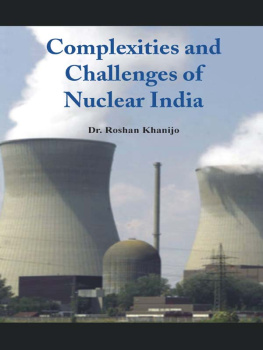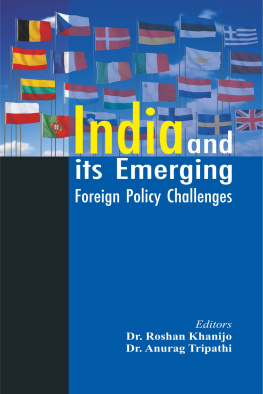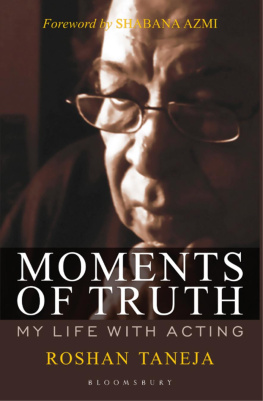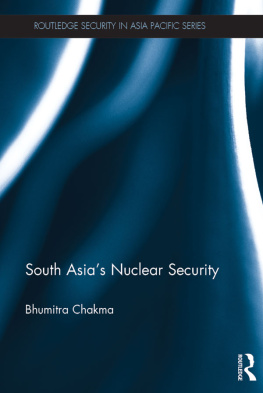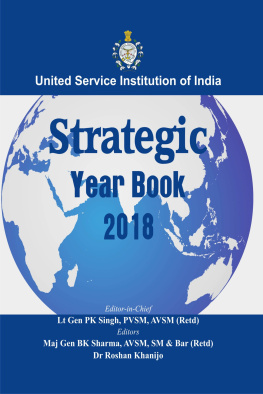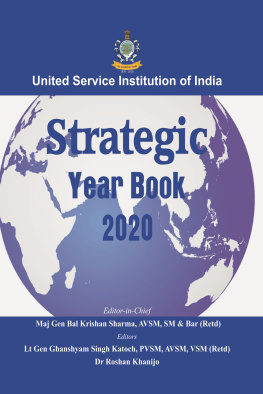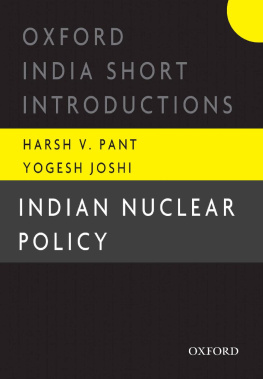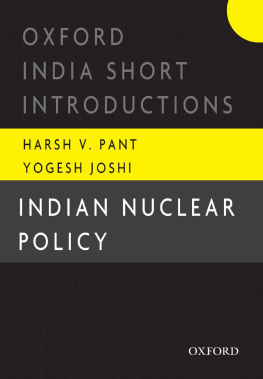Published by
Vij Books India Pvt Ltd
(Publishers, Distributors & Importers)
2/19,Ansari Road
Delhi-110002
Phones: 91-11-43596460, 91-11-47340674
Fax: 91-11-47340674
e-mail:
Copyright 2015, United Service Institution of India, New Delhi
ISBN: 978-9-382-65278-6
Price in India:

1250/-
All rights reserved.
No part of this book may be reproduced, stored in a retrieval system, transmitted or utilised in any form or by any means, electronic, mechanical, photocopying, recording or otherwise, without the prior permission of the copyright owner. Application for such permission should be addressed to the publisher.
The views expressed in the book are of the author and not necessarily those of the USI or publishers.
Printed and bound in India
Preface
Indias nuclear journey has always been an area of fascination for me. Whether it was Indias criticism of the NPT, or its overt declaration of becoming a Nuclear Weapon State in 1998, the ambiguity and mystery that has surrounded the development of Indias nuclear strategy, has become the hallmark of Indias nuclear policy. India is one of the few countries, whose leaders clearly understood the implications of the nuclear explosion in 1945. This cataclysmic event had upturned the security paradigms globally and countries were forced to rethink their strategies. Despite spearheading the shift to a Nuclear Age by becoming the first country in Asia to construct a nuclear reactor namely Apsara, India lost its initial momentum to China. China capitalized this opportunity, provided by the shifting power balance, by becoming a member of the UN Security Council. Moreover, through their systematic modernization process, China now has emerged as a potent force and a key nuclear nation.
Since India adopted the Civilian Nuclear Programme quite early, it becomes necessary to analyse the nuclear issue in a holistic manner. I consider it important to examine and understand the complexities and challenges posed, by the military as well as civilian sector. So, through this book, I am making an attempt to examine both. The feasibility of Thorium reactors, the multi-layered Asian threat, the changing global scenario and the efficacy of Indias nuclear doctrine and its force structure are some issues which require attention. In the civilian sector tracing the rise and progress of the power plants will provide an insight into the energy domain. As such India is going to face the energy crunch due to its depleting coal reserves. Nuclear energy may just try to narrow this gap. The closed nuclear cycle, adopted by the Indian scientists, which has been programmed to function through the use of thorium, needs to be re-examined in order to evaluate its applicability and efficacy. The feasibility of Thorium reactors has been debated worldwide but Indian scientists, however, have been aiming to formalize the three stage nuclear power generation as soon as possible. The sanctions which had been imposed on India, post the nuclear explosion of 1974, were relaxed subsequently, and the Indian nuclear industry revived its nuclear cooperation with other nations like Russia, France, South Korea etc. This was possible due to the Indo-US nuclear deal, which was a significant event in the civilian nuclear history of India, as it had opened the pathway for international cooperation. The nuclear deal should have ideally brought about a revolution in the nuclear industry in India, however, the question that has actually emerged out of this situation is whether India has been able to capitalize the opportunity or not. Researchers find themselves examining the fact that the Civil Liability Act, aimed at advancement, has ended up putting roadblocks on its progress instead. The Liability act, though beneficial in many ways, has also created many controversies. It has created negative publicity as far as investors are concerned, and foreign vendors remain reluctant to accept the act in totality.
The Fukushima disaster has brought the issues of nuclear safety and security to the forefront. There has been a lot of debate, regarding the emergency preparedness of Indias growing nuclear power plants. It has been suggested, that an Independent Regulatory Body that would serve as a watchdog, is essential to ensure the smooth functioning of the nuclear power plants. The need, for such an autonomous body has resurfaced once again due to growing doubts regarding the neutrality of the Atomic Energy Regulatory Body (AERB). Hence; all these issues need to be addressed in entirety. I have made an attempt, therefore, to research and analyse the civilian sector and understand the broad workings of this sector. The shortage of conventional energy sources - especially the depleting coal reserves - in conjunction with the reduced output of thermal power plants, has forced India to examine alternative sources of energy. Nuclear energy has the potential to grow, and help in mitigating the energy crisis that India is facing, provided high nuclear safety and security standards are maintained.
Post the 1962 Sino-Indian conflict, India is concerned about the intentions of China. The intermittent unapologetic border stand-offs and Chinas modernization of its nuclear weaponry - especially its missile inventory - remains a cause of concern. The nuclear missile race in Asia is causing geostrategic imbalance. Historically, with the disintegration of USSR, India was forced to rethink its strategic calculus. The emergence of China as an economic giant later on has reshaped the global power nexus. Hence there is a need to reassess the Indian position vis--vis this dramatic shift. Therefore, before understanding Indias nuclear policies, it is essential to perform a thorough environmental scan.
The environment post the Cold War, is very different, and the key factor now is the emergence of a major power shift, from Europe to Asia. This in turn has transformed the theory of warfare. Now more asymmetric methods of warfare are adopted by countries especially in Asia. Also for nations in Asia Nuclear Weapon is the central theme, in their strategic calculus, to maintain their territorial sovereignty. However; West, headed by America, have tried to downplay the importance of nuclear weapons, and their reliance on precession guided conventional weapons is a major policy changer for many Western countries. This difference in the strategic perception needs to be examined and evaluated. Additionally, nuclear deterrence has always been central to Asia. Whether it was direct or extended deterrence, nuclear deterrence has always had the potential to change the power nexus. Hence; any change in the present status quo, could wreak devastating effects on the precarious stability of the Asian subcontinent.
The 21st century has brought another type of warfare to the forefront, the genesis of which lies in the asymmetric warfare adopted by Pakistan. Pakistan has always competed with India, its inherent insecurity often carried due to the baggage of history, has created instability in South Asia. India cannot ignore Pakistan due to the geographical proximity of both the nations. The latters incessant nuclear competition, its growing nuclear arsenal and the fissile material production units, and its volatile intentions aimed at deploying tactical nuclear weapons, are cumulatively lowering the threshold in Asia. Pakistans offensive nuclear doctrine and its ever increasing red lines are escalating nuclear brinkmanship. The vindictive role of Non State Actors (NSAs), (trained in Pakistani soil), serve to make South Asia as a whole, (not just India) vulnerable to nuclear terrorism. The dangerous clouds of Dirty Bombs loom large in this region and remain a constant source of threat. Moreover, with the increasing number of covert and overt New Nuclear Weapons States (NNWS), nuclear material theft, sabotage and cyber-crimes, are other grave security issues that need to be addressed. Over and above this boiling pot of volatility, the growing bonhomie of Pakistan and China makes India vulnerable to a collusive Sino-Pak threat that India will find it difficult to fend off, without grave losses.

 1250/-
1250/-
